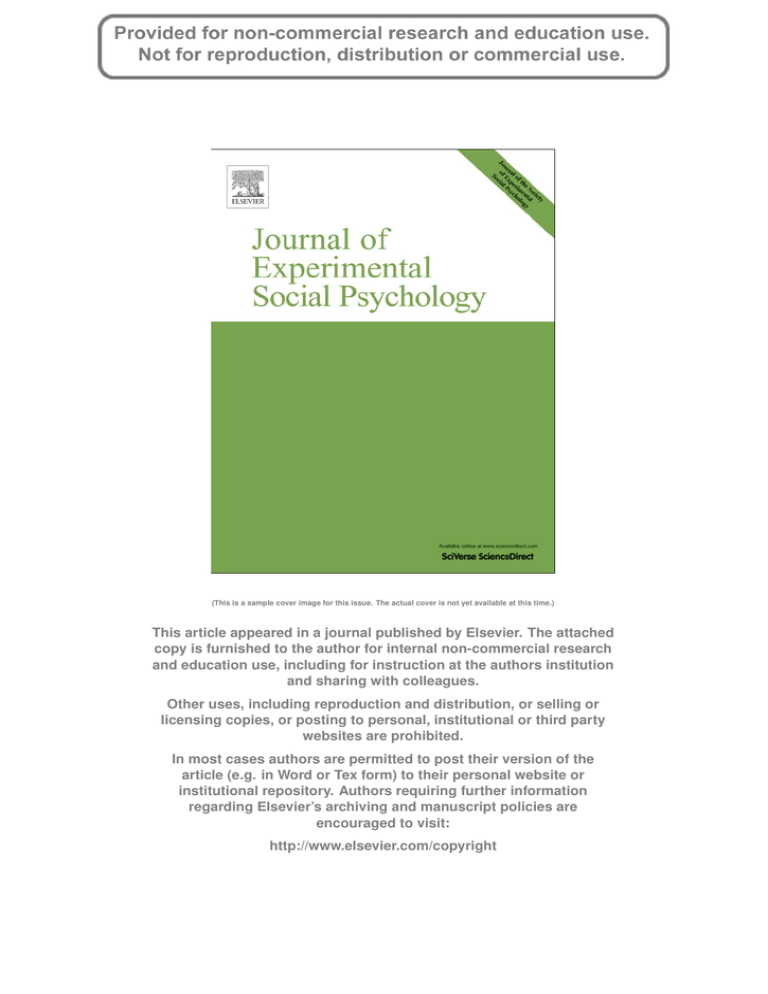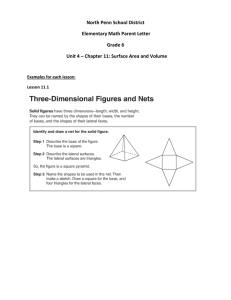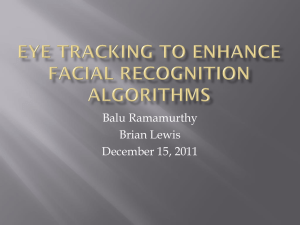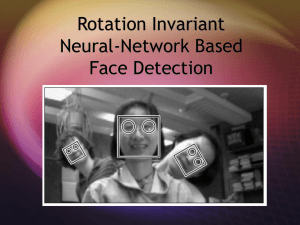
(This is a sample cover image for this issue. The actual cover is not yet available at this time.)
This article appeared in a journal published by Elsevier. The attached
copy is furnished to the author for internal non-commercial research
and education use, including for instruction at the authors institution
and sharing with colleagues.
Other uses, including reproduction and distribution, or selling or
licensing copies, or posting to personal, institutional or third party
websites are prohibited.
In most cases authors are permitted to post their version of the
article (e.g. in Word or Tex form) to their personal website or
institutional repository. Authors requiring further information
regarding Elsevier’s archiving and manuscript policies are
encouraged to visit:
http://www.elsevier.com/copyright
Author's personal copy
Journal of Experimental Social Psychology 49 (2013) 344–348
Contents lists available at SciVerse ScienceDirect
Journal of Experimental Social Psychology
journal homepage: www.elsevier.com/locate/jesp
FlashReport
Generalizing from human facial sexual dimorphism to sex-differentiate macaques:
Accuracy and cultural variation
Robert G. Franklin Jr.
a
b
a,
⁎, Leslie A. Zebrowitz a, Jean-Marc Fellous b, Annie Lee a
Brandeis University, USA
University of Arizona, USA
H I G H L I G H T S
►
►
►
►
We find humans can accurately sex-differentiate macaques based on the face alone.
Humans use cues that are sexually dimorphic in human faces to accomplish this task.
Asian observers perform better than Caucasian observers, due to their increased use of eye height.
These findings suggest cultural differences in how sexually-dimorphic cues affect person perception.
a r t i c l e
i n f o
Article history:
Received 23 August 2012
Revised 6 December 2012
Available online 27 December 2012
Keywords:
Cultural variation
Face perception
Sex perception
Social cognition
a b s t r a c t
Anthropomorphism in impressions of animals is commonplace, and this generalization from humans to animals is one example of a broader tendency to generalize from adaptively significant categories when judging
specific exemplars. Although anthropomorphism may lead to unlikely or incorrect judgments, it fostered accurate sex-differentiation of macaque faces due to an appropriate generalization from the sexually dimorphic
cues that distinguish human male and female faces to macaques. As predicted, Koreans performed better
than Caucasians in sex-differentiating macaque faces, a difference mediated by Koreans' greater use of sexually dimorphic eye height cues. These results extend and disambiguate evidence of East Asian superiority in
sex-differentiating human faces. Whereas an own-race advantage might explain the previous but not the
present findings, both can be explained by East Asians' keener sensitivity to sexually dimorphic cues, perhaps
owing to the greater subtlety of such cues in East Asian faces. Implications of this sensitivity for other cultural
differences in person perception are discussed.
© 2013 Elsevier Inc. All rights reserved.
Introduction
Humans frequently anthropomorphize non-human entities, giving
them human-like characteristics and interpreting their behavior in
human-like ways (Epley, Waytz, & Cacioppo, 2007). As recently argued
in a path-breaking special issue on anthropomorphism, this tendency is
a unique example of social perception in which the target is a
non-human entity (Kwan, Gosling, & John, 2008). The tendency to generalize from humans to other entities may be viewed as one example of
a broader tendency to generalize from adaptively significant categories
when judging specific exemplars. In particular, considerable research
indicates that first impressions of human faces reflect the generalization
of adaptive responses to other faces that they resemble, including baby
faces, familiar faces, anomalous faces, emotion faces, and even faces of
other species (Zebrowitz, Bronstad, & Montepare, 2011; Zebrowitz,
Wadlinger, et al., 2011). Whereas these generalization effects, like
⁎ Corresponding author at: Department of Psychology, Brandeis University, 415 South
Street, MS 062, Waltham MA 02454, USA.
E-mail address: rgfran@brandeis.edu (R.G. Franklin).
0022-1031/$ – see front matter © 2013 Elsevier Inc. All rights reserved.
http://dx.doi.org/10.1016/j.jesp.2012.12.008
anthropomorphism, often lead to incorrect judgments, the present
study investigated a situation in which anthropomorphic generalization
can foster accuracy. Specifically, we investigated whether generalizing
from the facial qualities that distinguish male and female human faces
(human sexual dimorphism) fosters accurate recognition of the sex of
rhesus macaque faces (Macaca mulatta). We also investigated whether
accuracy is greater among people whose ethnicity may require greater
sensitivity to sexually dimorphic cues in human faces, a question that
not only is interesting in its own right, but also can inform previous evidence for cultural differences in human face sex recognition.
Anthropomorphism in face perception
Many processes used when forming first impressions of people's
traits extend to perceptions of non-human animals. For example, people show high consensus and consistency when rating how well the
‘Big 5’ personality traits apply to pictures of dogs, suggesting the use
of appearance stereotypes in first impressions (Gosling, Kwan, &
John, 2003; Kwan et al., 2008). This also applies to face perception,
as well-documented facial appearance stereotypes influence first
Author's personal copy
R.G. Franklin Jr. et al. / Journal of Experimental Social Psychology 49 (2013) 344–348
impressions of animal faces. Specifically, Zebrowitz, Wadlinger, et al.
(2011) found an attractiveness halo effect in impressions of animal
faces, with more positive traits attributed to lions, foxes, and dogs
whose faces were judged more attractive than other animals from
the same species. The babyface stereotype also affected judgments
of animal faces, with more childlike traits attributed to animals
judged more babyfaced than others from the same species. Although
anthropomorphic impressions of animals may seem fanciful, commonalities in facial structure across different primates (e.g., Waller,
Parr, Gothard, Burrows, & Fuglevand, 2008), including sexual dimorphism, suggests that using knowledge of human faces may yield accurate impressions of primates' sex.
Sexual dimorphism and sex-differentiation
We are highly sensitive to the facial qualities that distinguish between female and male human faces, as shown in high accuracy in
sex-recognition, an ability established during the first year of life
(Quinn, Yahr, Kuhn, Slater, & Pascalis, 2002). The sexual dimorphism
in facial appearance derives from additional facial growth in males
and the masculinizing effects of male hormones that yield larger
jaws, larger noses, and more protrusive brow ridges, with the latter
yielding more prominent eyes in females (Enlow, 1990). Consistent
with this account, measurements of adult faces revealed that, compared with women, men have wider cheekbones, wider mouths, larger noses, longer faces, lower eyebrows, and smaller eye width and
height (Fellous, 1997; Gangestad & Thornhill, 2003; Penton-Voak et
al., 2001).
In macaques, as in humans, additional growth in males during adolescence leads to wider faces and larger jaw structures (Wang, Dechow,
& Hens, 2007). These sex differences are sufficient for macaques to recognize female and male macaques based on the face alone (Koba, Izumi,
& Nakamura, 2009). Since human and macaque faces show some of the
same sexually dimorphic qualities and since humans use these qualities
to recognize the sex of other humans, they also may be able to recognize
the sex of macaque faces by generalizing their expertise with human
faces. Such an achievement would stand in contrast to evidence that
training is required for people to accurately sex-differentiate other
species for which generalizing from human sexual dimorphism is not
useful, including day-old chicks (Biederman & Shiffrar, 1987) and facial
images of cats (Quinn, Palmer, & Slater, 1999). Establishing human
accuracy in sex-differentiating macaque faces is significant for the
field of social perception because it would underscore the power of
generalization effects. Specifically, it would demonstrate that the previously established tendency for people to generalize from known face
categories to non-category members who resemble them (Zebrowitz,
Bronstad, et al., 2011) is sufficiently strong that it even influences perceptions of other species. Showing that people generalize their knowledge of
human faces when judging macaque faces also has implications for understanding conditions conducive to anthropomorphism, suggesting
that it may be facilitated when perceivers can detect physical similarities
between humans and non-human entities.
Cultural differences in sex-differentiation
There also may be individual differences in the ability of humans
to sex-differentiate macaque faces. Although accurate face recognition develops early in life, developmental processes can affect what
information is extracted from faces. For example, six-month old infants were equally able to discriminate differences in the identity of
macaque and human faces, while nine-month infants and adults
were better at discriminating human than macaque face identity
(Pascalis, de Haan, & Nelson, 2002), indicating that early childhood
exposure to human faces increases the specialization for processing
human faces above other facial examples. Supporting this, exposure
345
to macaque faces between 6 and 9 months helps prevent this loss of
the ability to discriminate macaque faces (Pascalis et al., 2005).
The effects of perceptual experience suggest that cultural variations may exist in the ability to sex-differentiate faces. In particular,
those whose perceptual experiences would foster greater expertise
recognizing sexually dimorphic cues in human faces may show superior sex-differentiation of macaque faces. Since there is less sexual
dimorphism in East Asian versus Caucasian faces (Brown, 1999;
Kunjur, Sabesan, & Ilankovan, 2006; Zebrowitz, Kikuchi, & Fellous,
2010), East Asians may have developed greater expertise recognizing sexual dimorphism in human faces. Consistent with this possibility, not only is it is more difficult to sex-differentiate Japanese
than Caucasian faces, but this greater difficulty was less marked
for Asian-American judges (O'Toole, Peterson, & Deffenbacher,
1996; Zhao & Bentin, 2008). Although the better performance of
Asian-American judges could reflect an own-race bias rather than
greater sensitivity to sexual dimorphism, the former explanation
can be ruled out if Asian-Americans also show better performance
sex-differentiating macaque faces. Moreover, clear evidence that
Asian-Americans are more sensitive to sexual dimorphism is pertinent
to possible cultural differences in person perception, since the use of
sexually dimorphic cues is implicated in stereotyping and emotion recognition (Becker, Kenrick, Neuberg, Blackwell, & Smith, 2007; Sczesny,
Spreemann, & Stahlberg, 2007).
Hypotheses
We tested four hypotheses. First, we predicted that humans would
be able to sex-differentiate macaques from facial cues alone. Second,
we predicted that sex-differentiation accuracy would be stronger for
East Asian than Caucasian participants. Third, we predicted that face
width, jaw size, nose size, and eye size would predict macaque face
sex. Fourth, we predicted that these characteristics would be used
by human observers.
Method
Participants
Thirty-six Korean office workers (16 female, 20 male) from Seoul,
Korea volunteered for this study in exchange for a brief break from
work. Thirty Caucasian students (20 female, 10 male) at an American
university participated in this study for $10 compensation.
Stimuli
Thirty grayscale images of rhesus macaques (M. mulatta) (15 female
and 15 male) were selected from the Gothard Primate Lab at the University of Arizona (Gothard, Erickson, & Amaral, 2004). Images
consisted of macaques with a closed-mouth neutral expression and no
head tilt. Images were resized to 7.5× 7.5 cm and cropped to only
show the head and neck region. Female and male images were matched
on the brightness of the fur as rated by 3 raters (t(29) = .01, p = .99).
We use macaque faces as stimuli both for the theoretical reason that
they share sexually dimorphic features with humans, and also for the
practical reason that these primate faces were available to us.
Facial metrics
Macaque images were measured by using computer software to
digitize 72 points on the face. Two judges marked all the faces in
order to establish interrater reliability for the distances calculated
from the points. We calculated 11 distances from these digitized
points that captured previously documented sex differences in
human and macaque faces (see Fig. 1). These were face width (W4),
jaw width (W1), nose width (N2), eye width (E4), mouth width
Author's personal copy
346
R.G. Franklin Jr. et al. / Journal of Experimental Social Psychology 49 (2013) 344–348
(M0), face length (C1), chin length (C3), nose length (N3), and eye
height (E5). To adjust for head size variations, the metrics in the horizontal dimension were normalized by pupil distance (E2) while the
metrics in the vertical dimension were normalized by head length
(L0).
Design and procedure
An interactive slideshow was created using the program DirectRT,
in which participants were asked to sex differentiate the macaque
faces as quickly and as accurately as possible. Participants viewed
the 30 images of macaques in random order and each image
remained on the screen until the participant pressed a keyboard key
to indicate the sex of the macaque.
Results
Accuracy sex-differentiating macaque faces
Participants' sex-differentiation showed 60.9% accuracy, (M = 18.3
out of 30), which was significantly greater than chance (50%),
t(65) = 8.25, p b .001, d = 2.05. Further, each combination of participant sex by participant culture performed significantly better than
chance, all ts > 2.81, all ps b .02. As predicted, Korean participants' accuracy (63.2%) was higher than that of the Caucasian participants
(58.1%), t(58) = 1.95, p = .056, d = .51. There was no difference between the accuracy of female (59.9%) and male (62.1%) participants,
t(63) = .83.
Facial metric predictors of macaque sex
The 9 facial metrics assessed to test our hypotheses achieved acceptable inter-rater agreement between two raters (correlations
ranged from r = .70 to .98, M = .86), and mean values across raters
were computed to examine correlations with macaque sex (coded
0 for female, 1 for male). Consistent with previous research on sexual
dimorphism in human and/or macaque faces, measures of face length
and width, jaw size, nose size, and eye size, were significant predictors of macaque sex, paralleling the sexual dimorphism of these features in human faces (see Table 1).
Facial metric predictors of perceived macaque sex
We used sensitivity correlations to examine which cues were significantly used by Korean and Caucasian raters and which cues were
differentially used by the two groups. We correlated each rater's
judgment of the sex of the faces (coded 0 for female, 1 for male)
with each facial metric. This yielded a set of correlations for each participant reflecting the extent to which each metric was correlated
with their judgments of face sex. These correlations were Fisher-Z
transformed to normalize them (see Franklin & Adams, 2009), and
the mean of the normalized correlations across Caucasian or Korean
raters was compared to zero by using a t-test to determine which
metrics significantly predicted rated sex (see Table 2).
As reported in Table 2, judgments of face sex by both Korean and
Caucasian raters were predicted by all of the metrics that significantly
differentiated macaque sex. The only significant cultural difference in
cue utilization was eye height (E5), which predicted sex judgments
Fig. 1. Facial metrics used to examine sexual dimorphism in macaque faces.
Author's personal copy
R.G. Franklin Jr. et al. / Journal of Experimental Social Psychology 49 (2013) 344–348
Table 1
Facial metrics reliability and its correlation with macaque sex.
Metric
C1 — eye to chin
length
C3 — chin length
E2 — interpupil
distance
E4 — eye width
E5 — Eye Length
L0 — head length
M0 — mouth
width
N2 — nose width
N3 — nose length
W1 — jaw width
W4 — face width
Males Females Reliability
Correlation t-Value p-Value
with face sex
2.14
1.94
0.95
0.52
3.52
0.002
0.46
0.23
0.39
0.23
0.70
0.98
0.31
0.15
2.78
0.81
0.01
0.42
0.97
0.26
0.79
1.12
0.97
0.28
0.75
0.85
0.80
0.82
0.93
0.88
−0.01
−0.68
0.38
0.69
0.06
2.81
2.18
4.99
0.95
b.001
0.038
b.001
0.47
1.18
1.49
2.25
0.44
1.07
1.25
2.16
0.93
0.91
0.74
0.88
0.51
0.32
0.67
0.36
3.12
2.12
4.83
2.03
0.004
0.043
b.001
0.052
Sex was scored as 0 = female; 1 = male.
Table 2
Mean sensitivity correlations between facial metrics and rated sex.
Measure
Mean
t-Value
p-Value
C1 — eye to chin distance
C3 — chin length
E2 — interpupil distance
E4 — eye width
E5 — eye height
L0 — head length
M0 — mouth width
N2 — nose width
N3 — nose length
W1 — jaw width
W4 — face width
0.20
0.01
−0.03
−0.02
−0.27
0.14
0.12
0.10
0.29
0.17
0.14
7.90
0.29
−1.45
−0.76
−9.17
5.11
5.17
3.84
8.92
7.57
6.67
0.00
0.90
0.45
0.90
0.00
0.00
0.00
0.00
0.00
0.00
0.00
Correlations are between an individual's rating of sex scored as 0 = female and 1 =
male; thus positive correlations indicate that the metric is larger in macaques labeled
as male.
more for Asians than Caucasians, t(53) = 2.13, p = .038. For all other
metrics, the culture comparison was not significant, ts b 1.5, ps > .1.
As eye height significantly differentiated judgments by Korean
and Caucasian raters and also accurately predicted macaque sex, we
examined whether it mediated the cultural difference in accuracy.
The mediation analysis (Baron & Kenny, 1986; Preacher & Hayes,
2004) revealed that Korean raters' greater use of eye height fully mediated the relationship between culture and accuracy. Controlling for
its use reduced the better performance of Koreans to a non-significant
effect, and this drop was significant (see Fig. 2).
Discussion
This is the first study to demonstrate that humans can sexdifferentiate primate faces, an achievement that likely reflects crossspecies similarity in the cues that differentiate male from female
faces. Specifically, we found that compared with female macaques,
347
male macaques have larger and broader jaws, longer lower faces,
wider faces, larger noses, and smaller eye heights, paralleling facial
metrics that differentiate male from female humans (Fellous, 1997;
Gangestad & Thornhill, 2003; Penton-Voak et al., 2001). Furthermore,
we found that humans appropriately used each of these sexuallydimorphic cues to judge macaque sex. Thus, anthropomorphism
enables people to accurately sex-differentiate macaque faces by appropriately generalizing from sexual dimorphism in human faces.
These results add to previous evidences that social perceptions of specific exemplars tend to generalize from adaptively significant categories. For example, responses to adaptively significant facial cues, like
those of a baby or an angry person, generalize to perceptions of people whose faces merely resemble babies or anger. Our results also
suggest that objective similarities in the physical appearance of
humans and animals may contribute to other instances of anthropomorphism, providing one answer to the question of what conditions
increase or decrease anthropomorphism, and supporting the suggestion that anthropomorphism may be inextricably intertwined with
the way we see humans (Kwan & Fiske, 2008).
We also found that Koreans performed better than Caucasians in
sex-differentiating macaque faces, extending evidence of cultural
variation in human sex-differentiating ability. Even though this effect
was small, the magnitude of the difference between Asian and
Caucasian judges was similar to that shown when judging human
sex (e.g., Zhao & Bentin, 2008). Moreover, the superiority of East
Asians in judging macaque sex disambiguates the East Asian advantage previously shown for human faces. Specifically, previous evidence that lower accuracy in sex-differentiating Asian faces was less
marked for Asian judges (O'Toole et al., 1996) could have reflected either Asians' keener sensitivity to sexually dimorphic facial cues owing
to the greater subtlety of such cues in East Asian faces or it could have
reflected an own-race advantage. However, an own-race advantage
cannot account for Korean judges' greater accuracy in sexdifferentiating macaque faces. Thus, the present results support the
conclusion that East Asians are more sensitive to facial sexual
dimorphism, an effect shown for both human and macaque faces. In
the case of macaques, the only cue to which Koreans were more sensitive was eye size, and greater use of this cue fully mediated their
greater accuracy. Koreans' greater use of eye size is consistent with
prior research suggesting that East Asians use cues in the eye region
more so than do Caucasians when sex-differentiating human faces
(Yamaguchi, Hirukawa, & Kanazawa, 1995).
Koreans' greater sensitivity to sexually-dimorphic cues suggests
that these cues may play a more important role in person perception
processes in East Asian cultures. For example, the tendency to attribute more stereotypically masculine traits to persons with a typically
masculine versus feminine facial appearance, regardless of the
person's sex (Sczesny et al., 2007) may be stronger for East Asians.
Similarly, the tendency for congruence between emotion cues and
sexual dimorphism cues (Zebrowitz et al., 2010) to yield quicker
and more accurate recognition of fear in women and anger in men
(Becker et al., 2007) may also be stronger in East Asians. These are interesting questions for future research.
Fig. 2. Mediation model for the use of eye size mediating the relationship between participant culture (0 = White American, 1 = Korean) and accuracy. Participant culture was
coded 0 = White American, 1 = Korean, thus indicating that positive correlations with participant culture indicate greater use of eye size and greater accuracy in Korean raters.
Author's personal copy
348
R.G. Franklin Jr. et al. / Journal of Experimental Social Psychology 49 (2013) 344–348
Acknowledgments
The authors thank Dr. Katalin Gothard for providing the macaque
images and Jesse Lee and Melany Vidret for their help in data collection.
References
Baron, R. M., & Kenny, D. A. (1986). The moderator–mediator variable distinction in
social psychological research: Conceptual, strategic, and statistical considerations.
Journal of Personality and Social Psychology, 51, 1173–1182.
Becker, D. V., Kenrick, D. T., Neuberg, S. L., Blackwell, K. C., & Smith, D. M. (2007). The
confounded nature of angry men and happy women.
Biederman, I., & Shiffrar, M. M. (1987). Sexing day-old chicks: A case study and expert
systems analysis of a difficult perceptual-learning task. Journal of Experimental
Psychology: Learning, Memory, and Cognition, 13, 640–645.
Brown, T. (1999). Facial profiles: Population standards and variability. Perspectives in
Human Biology, 4, 135–144.
Enlow, D. H. (1990). Facial growth. Philadelphia: Saunders.
Epley, N., Waytz, A., & Cacioppo, J. T. (2007). On seeing human: A three-factor theory of
anthropomorphism. Psychological Review, 114, 864–886.
Fellous, J. M. (1997). Gender discrimination and prediction on the basis of facial metric
information. Vision Research, 37, 1961–1973.
Franklin, R. G., & Adams, R. B. (2009). A dual-process account of female facial attractiveness preferences: Sexual and nonsexual routes. Journal of Experimental Social
Psychology, 45, 1156–1159.
Gangestad, S. W., & Thornhill, R. (2003). Facial masculinity and fluctuating asymmetry.
Evolution and Human Behavior, 24, 231–241.
Gosling, S. D., Kwan, V. S., & John, O. P. (2003). A dog's got personality: A cross-species
comparative approach to personality judgments in dogs and humans. Journal of
Personality and Social Psychology, 85, 1161–1169.
Gothard, K. M., Erickson, C. A., & Amaral, D. G. (2004). How do monkeys look at faces in
a visual paired comparison task? Animal Cognition, 7, 25–36.
Koba, R., Izumi, A., & Nakamura, K. (2009). Sexual dimorphism in facial shapes and
their discrimination in Japanese monkeys (Macaca fuscata). Journal of Comparative
Psychology, 123, 326–333.
Kunjur, J., Sabesan, T., & Ilankovan, V. (2006). Anthropometric analysis of eyebrows and
eyelids: An inter-racial study. British Journal of Oral and Maxillofacial Surgery, 44,
89–93.
Kwan, V. S. Y., & Fiske, S. T. (2008). Missing links in social cognition: The continuum
from nonhuman agents to dehumanized humans. Social Cognition, 26(2), 125–128.
Kwan, V. S. Y., Gosling, S. D., & John, O. P. (2008). Anthropomorphism as a special case
of social perception: A cross-species social relations model analysis of humans and
dogs. Social Cognition, 26, 129–142.
O'Toole, A. J., Peterson, J., & Deffenbacher, K. A. (1996). An ‘other-race effect’ for categorizing faces by sex. Perception, 25, 669–676.
Pascalis, O., de Haan, M., & Nelson, C. A. (2002). Is face processing species-specific during the first year of life? Science, 296(5571), 1321–1323.
Pascalis, O., Scott, L. S., Kelly, D. J., Shannon, R. W., Nicholson, E., Coleman, M., et al.
(2005). Plasticity of face processing in infancy. Proceedings of the National Academy
of Sciences of the United States of America, 102(14), 5297–5300.
Penton-Voak, I. S., Jones, B. C., Little, A. C., Baker, S., Tiddeman, B., Burt, D. M., et al.
(2001). Symmetry, sexual dimorphism in facial proportions and male facial attractiveness. Proceedings of the Royal Society of London, Series B: Biological Sciences,
268(1476), 1617–1623.
Preacher, K. J., & Hayes, A. F. (2004). SPSS and SAS procedures for estimating indirect
effects in simple mediation models. Behavior Research Methods, 36, 717–731.
Quinn, P. C., Palmer, V., & Slater, A. M. (1999). Identification of gender in domestic-cat
faces with and without training: Perceptual learning of a natural categorization
task. Perception, 28, 749–764.
Quinn, P. C., Yahr, J., Kuhn, A., Slater, A. M., & Pascalis, O. (2002). Representation of the
gender of human faces by infants: A preference for female. Perception, 31, 1109–1122.
Sczesny, S., Spreemann, S., & Stahlberg, D. (2007). Masculine = competent? Physical
appearance and sex as sources of gender-stereotypic attributions. Swiss Journal of
Psychology, 65, 15–23.
Waller, B. M., Parr, L. A., Gothard, K. M., Burrows, A. M., & Fuglevand, A. J. (2008).
Mapping the contribution of single muscles to facial movements in the rhesus
macaque. Physiology & Behavior, 95(1–2), 93–100.
Wang, Q., Dechow, P. C., & Hens, S. M. (2007). Ontogeny and diachronic changes in
sexual dimorphism in the craniofacial skeleton of rhesus macaques from Cayo
Santiago, Puerto Rico. Journal of Human Evolution, 53, 350–361.
Yamaguchi, M., Hirukawa, T., & Kanazawa, S. (1995). Judgment of gender through facial
parts. Perception, 24(5), 563–575.
Zebrowitz, L. A., Bronstad, M. P., & Montepare, J. M. (2011a). An ecological theory of
face perception. In N. Ambady, R. Adams, K. Nakayama, & S. Shimojo (Eds.), The
science of social vision (pp. 3–30). Oxford University Press.
Zebrowitz, L. A., Kikuchi, M., & Fellous, J. M. (2010). Facial resemblance to emotions:
Group differences, impression effects, and race stereotypes. Journal of Personality
and Social Psychology, 98, 175–189.
Zebrowitz, L. A., Wadlinger, H. A., Luevano, V. X., White, B. M., Xing, C., & Zhang, Y.
(2011b). Animal analogies in first impressions of faces. Social Cognition, 29,
486–496.
Zhao, L., & Bentin, S. (2008). Own-and other-race categorization of faces by race,
gender, and age. Psychonomic Bulletin & Review, 15, 1093–1099.







